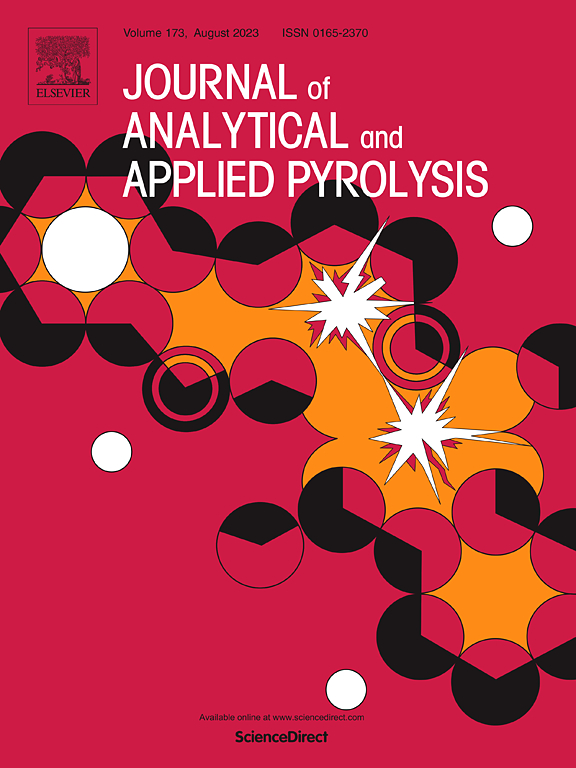Study on the mechanism of the characteristics of biochar changed by tobacco stalk macromolecules volatile-char interaction
IF 5.8
2区 化学
Q1 CHEMISTRY, ANALYTICAL
引用次数: 0
Abstract
Tar and char, as products of the pyrolysis process, do not separate during the reaction in the gasifier. Char particles are continually surrounded by volatiles, and the interaction between volatile-char in the bed layer causes changes in the physicochemical structure of the char. Based on this, a dual-stage connected system was used in a self-constructed solid fuel thermal conversion experimental setup, with demineralized tobacco stalks as the sample. The interlayer interaction between volatile-char at different pyrolysis temperatures were studied, and the effects of these interactions on char were comprehensively analyzed in terms of char gasification reactivity and macromolecular volatile composition. Thermogravimetric analysis results indicate that the deposition of volatiles on the char surface reduces the char's gasification reactivity, leading to an increase in the activation energy required for the gasification reaction. The composition of the tar obtained from the pyrolysis of demineralized tobacco stalks was determined, and it was found to primarily consist of monoaromatic compounds, oxygenated compounds, nitrogenated compounds, aliphatic hydrocarbons, and polyaromatic hydrocarbons. As the pyrolysis temperature increases, the proportion of monoaromatic compounds rises, while the content of oxygenated compounds decreases. Polyaromatic hydrocarbons begin to appear at 600 ℃ and at this temperature, tar molecules further crack or undergo secondary reactions. The interaction has altered the pore structure of the char, leading to a reduction in its active specific surface area from 62.27 m2/g to 33.91 m2/g, while the total pore volume and micro-pore volume have decreased by 33.84 % and 44.26 %, respectively. These interactions involve the transfer of electron pairs from the more stable chemical bonds in the char to the structure of the tar, leading to bond cleavage, the formation of free radicals, and subsequent reactions with the functional groups on the char surface. During this process, the degree of graphitization of the char increases, and the content of oxygen-containing functional groups decreases from 24.19 % to 22.01 %, 21.37 %, and 19.05 %. Oxygen-containing functional groups serve as active sites for the char gasification reaction. A strong linear relationship exists among the char's active specific surface area, the reaction activation energy, and the content of oxygen-containing functional groups.
烟草秸秆大分子挥发物-炭相互作用改变生物炭特性的机理研究
焦油和炭作为热解过程的产物,在气化炉的反应过程中不会分离。炭颗粒不断被挥发物包围,床层中挥发物与炭的相互作用导致炭的物理化学结构发生变化。在此基础上,以脱矿后的烟草秸秆为样品,在自建的固体燃料热转化实验装置中,采用双级连接系统。研究了不同热解温度下挥发物与焦炭层间的相互作用,并从焦炭气化反应性和大分子挥发物组成等方面综合分析了这些相互作用对焦炭的影响。热重分析结果表明,挥发物在焦炭表面的沉积降低了焦炭的气化反应活性,导致气化反应所需的活化能增加。对脱盐烟草秸秆热解所得焦油的组成进行了测定,发现其主要由单芳香族化合物、含氧化合物、含氮化合物、脂肪烃和多芳香族烃组成。随着热解温度的升高,单芳香族化合物的比例升高,含氧化合物的含量降低。600℃时开始出现多芳烃,在此温度下,焦油分子进一步裂解或发生二次反应。这种相互作用改变了炭的孔隙结构,使其活性比表面积从62.27 m2/g减小到33.91 m2/g,总孔容和微孔体积分别减小了33.84 %和44.26 %。这些相互作用包括电子对从碳中更稳定的化学键转移到焦油的结构中,导致键断裂,自由基的形成,以及随后与碳表面官能团的反应。在此过程中,炭的石墨化程度提高,含氧官能团的含量从24.19 %下降到22.01 %、21.37 %和19.05 %。含氧官能团是炭气化反应的活性位点。炭的活性比表面积、反应活化能与含氧官能团的含量之间存在较强的线性关系。
本文章由计算机程序翻译,如有差异,请以英文原文为准。
求助全文
约1分钟内获得全文
求助全文
来源期刊
CiteScore
9.10
自引率
11.70%
发文量
340
审稿时长
44 days
期刊介绍:
The Journal of Analytical and Applied Pyrolysis (JAAP) is devoted to the publication of papers dealing with innovative applications of pyrolysis processes, the characterization of products related to pyrolysis reactions, and investigations of reaction mechanism. To be considered by JAAP, a manuscript should present significant progress in these topics. The novelty must be satisfactorily argued in the cover letter. A manuscript with a cover letter to the editor not addressing the novelty is likely to be rejected without review.

 求助内容:
求助内容: 应助结果提醒方式:
应助结果提醒方式:


